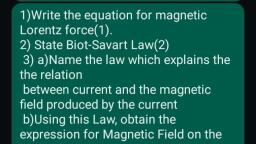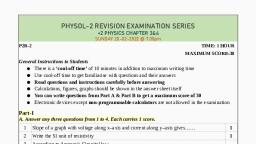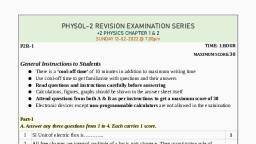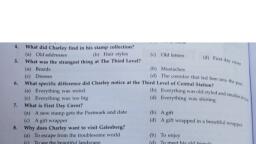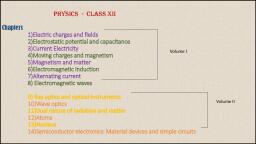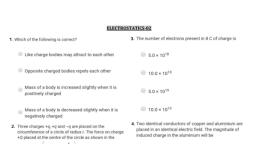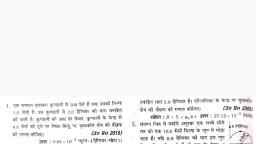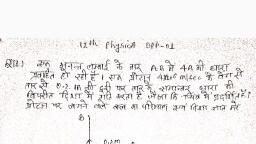Question 3 :
A charge is kept at the centre of a shell. Shell has charge Q uniformally distibuted over its surface and radius R. The force on the central charge due to the shell is :
Question 4 :
<p><span class="wysiwyg-font-size-small"><span class="wysiwyg-font-size-small">A body has a charge of <font size="3">$9.6 \times 10^{-20}$</font><span class="wysiwyg-font-size-small"><span class="wysiwyg-font-size-small">coulomb. It is :</p>
Question 5 :
Two charged spheres separated at a distance d exert a force F on each other. If they are immersed in a liquid of dielectric constant 2, then the force (if all conditions are same) is :
Question 6 :
Which of the following statements are true:A: Charge cannot exist without mass but mass can exist without charge<br/>B: Charge is invariant but mass varies with velocity<br/>C: Charge is conserved but mass alone may not be conserved
Question 8 :
A point charge $+q$ is placed at the centre of a cube of side L. The electric flux emerging from the cube is
Question 9 :
A point charge ${q_1} =  - 5.8\mu C$ is held stationary at the origin . A second point charge ${q_2} =  + 4.3\mu C$ moves from the point $(0.26m,0,0)$ to $(0.38m,0,0)$.How much work is done by the electric force on {q_2}.
Question 10 :
Calculate the magnitude of the force between two electrons which are separated by a distance of $10^{-10}m$. If the magnitude of the charge is $10^{-19}C$ and Coulomb constant is $10^{10}N\;m^{2}/C^{2}$.
Question 14 :
fast neutrons may most easily be slowed down by which one of the following methods?
Question 15 :
Two coils 'P' and 'Q' are separated by some distance. When a current of $3$ A flows through coil 'P', a magnetic flux of $10^{-3}$ Wb passes through 'Q'. No current is passed through 'Q'. When no current passes through 'P' and a current of $2$A passes through 'Q', the flux through 'P' is?
Question 17 :
Charging by friction is accompanied by loss or gain of electrons. State which body loses electrons when a glass rod is rubbed with silk.
Question 18 :
The field due to a charge at a distance $x$ from it is $E$. When the distance is doubled, the intensity of the field would be:
Question 19 :
<p><span class="wysiwyg-font-size-small"><span class="wysiwyg-font-size-small">A body has a total charge of <span class="wysiwyg-font-size-medium"><span class="wysiwyg-font-size-medium">$6.4\times  10^{-19}$<span class="wysiwyg-font-size-small"><span class="wysiwyg-font-size-small">coulomb. It is :</p>
Question 20 :
What will bethe effect on the divergence of the leaves of aunchargedgold leaf electroscope onbringing a negatively charged rod near electroscope?
Question 21 :
Materials which allow larger currents to flow through them are called :
Question 22 :
A hollow conducting sphere of charge does not have electric field at
Question 23 :
The charges from one body can be Transferred to another body but the total charge of a system ...........<br>
Question 24 :
When a negative charge is taken at a height from earth's surface, then its potential energy:
Question 25 :
The process due to which an uncharged body acquires electric charges when held near a charged body is called :<br/>
Question 26 :
Two identical metallic spheres A and B of exactly equal masses are given equal positive and negative charge respectively. Then:
Question 27 :
Negative electric flux indicates that electric lines of force are directed
Question 30 :
In a region of space, the electric field is given by $\vec {E} = 8\hat {j} + 4\hat {j} + 3\hat {k}$. The electric flux through a surface of area of $100$ units in $x - y$ plane is?
Question 31 :
<span class="wysiwyg-font-size-small"><span class="wysiwyg-font-size-small"><p class="wysiwyg-text-align-left">A charge q is enclosed in a cube at its geometrical centre. What is the electric flux associated with one of the faces of cube:</p>
Question 32 :
State whether true or false.<br/>Pure water is a good conductor of electricity.<br/>
Question 33 :
If the electric force between two unknown charges is attractive, identify which of the following statement must be true?<br/>
Question 34 :
<span class="wysiwyg-font-size-small"><span class="wysiwyg-font-size-small"><p class="wysiwyg-text-align-left">Number of electric lines of force emanating from $1C$ of positive charge in vacuum is :</p>
Question 35 :
<p class="wysiwyg-text-align-left">A charge $Q\  \mu C$ is placed at the centre of a cube. The flux coming out from any surface will be :<br/></p>
Question 36 :
Assertion: Sometime, a crackling sound is heard while taking off sweater during winters.
Reason: This is due to static electric charges.
Question 37 :
If $10^{20}$ <span class="wysiwyg-font-size-small"><span class="wysiwyg-font-size-small">electrons are removed from a conductor. The nature and magnitude of the charge developed on it is :
Question 39 :
A plane area of $100\ {cm}^{2}$ is placed in uniform electric field of $100\ N/C$ such that the angle between area vector and electric field is $60^o$. The electric flux over the surface is
Question 40 :
<span class="wysiwyg-font-size-small"><span class="wysiwyg-font-size-small"><p class="wysiwyg-text-align-left">The electric field due to a charge at a distance of $3m$ from it is $500 N/C$. The magnitude of the charge is$\left [ \dfrac{1}{4\pi \varepsilon _{0}}=9\times 10^{9}Nm^{2}/C^{2} \right ]$ :</p>
Question 41 :
What is the ratio of electric field intensity at distance $5$ cm to that at $10$ cm from a point charge $Q$ in air?<br/>
Question 42 :
Two conducting charged spheres $X$ and $Y$ having unequal charges are connected by the wire. Which of the following is true?
Question 44 :
the number of electric field lines emerged out of 1 C charge is
Question 45 :
An electron and a proton are both released from rest 1 meter from a large stationary negative charge, considering only the force from the large stationary negative charge on the proton and electron. Which of the following is true?
Question 46 :
The specific charge of a proton is $\displaystyle 9.6\times { 10 }^{ 7 }C/kg$. The specific charge of an alpha particle will be:
Question 48 :
A charge q is located at the centre of a cube.The electric flux through any face is -
Question 49 :
A gold leaf electroscope is given a positive charge so that its leaves diverge. How is the divergence of leaves affected, when an uncharged rod is brought near its disc ?
Question 51 :
A dipole of dipole moment $p$ is rotated by angle $\pi$ in a uniform electric field of strength $E$. The work required.
Question 52 :
An electric dipole is placed in an electric field generatedby a point charge.
Question 53 :
Four charges ${q}_{1}=1\mu C$, ${q}_{2}=2\mu C$, ${q}_{3}=3\mu C$ and ${q}_{4}=4\mu C$ are placed at $(0,0,0)$, $(1m,0,0)$, $(0,1m,0)$, $(0,0,1m)$ respectively. Let $\vec { { F }_{ i } } $ be the net force acting on $i$th charge of the given charges then $\sum { \vec { { F }_{ i } } } =....$
Question 54 :
A charge q is released in presence of electric (E) and magnetic field (B) then after some time its velocity is v then:-
Question 55 :
The electricity developed on objects, when they are rubbed with each other is called:
Question 56 :
The sum of all electromagnetic forces between different particles of a system of charged particles is zero:<br/>
Question 57 :
Two identical charged spheres suspended from a common distance $d(d < < 1)$ apart because of their mutual repulsion. The charged begin to leak from both the spheres at a constant rate. As a result, the spheres approach each other with a velocity $v$. Then $v$ varies as a function of the distance $x$ between the spheres, as
Question 58 :
A small plastic ball of mass m covered with a thin zinc coating, is suspended by means of an insulating thread from a fixed point. There exists an electric field of magnitude E directed along horizontal. Now ultraviolet light is made to incident on the ball due to which it acquires a positive charge. Acceleration due to gravity is g.<br/>(a) What is the origin of positive charge acquired by the ball ?<br/>
Question 59 :
A parallel plate capacitor is made of two circular plates separated by a distance of $5\ mm$ and with a dielectric of dielectric constant $2.2$ between them. When the electric field in the dielectric field in the dielectric is $3 \times 10^4\ V/m$, the charge density of the positive plate will be close to :
Question 60 :
<p>Two bodies X and Y carry charges $ - 6.6\mu C$  and $ - 5\mu C$.How many electrons should be transferred from X and Yso that they acquire equal charges?</p>
Question 61 :
The force between two charges when placed in free space is 5 N.If they are in a medium of relative permittivity 5, the force between them willbe
Question 62 :
A point charge is brought in an electric field. The electric field at a nearly point :
Question 63 :
<span class="wysiwyg-font-size-small"><span class="wysiwyg-font-size-small"><p class="wysiwyg-text-align-left">Two equally charged identical metal spheres A and B repel each other with a force F. Another identical uncharged sphere C is touched to A and then placed midway between A and B. The net force on C is in the direction:</p>
Question 64 :
The force between two charges $2\mu C$ and $4\mu C$ is $24 N$, when they are separated by a certain distance in free space. The forces if, $(a)$ distance between them is doubled and $(b)$ distance is halved are :
Question 65 :
What is the value of $E$ in the space outside the charged sheets?
Question 66 :
A hemisphere shell is uniformly charged positively. The electric field at a point on a diameter away from the centre (inside the boundary of hemisphere shell) is directed
Question 67 :
State whether true or false :Rain water is a non-conductor of electricity.
Question 68 :
$\begin{array} { l } { \text { Four equal charges } Q \text { are placed at the four corners of a square of side a each. Work done i } } \\ { \text { removing a charge } - Q \text { from its centre to infinity is: } } \end{array}$
Question 69 :
If the force between two charged objects is to be left unchanged, even though the charge on one of the objects is halved, keeping the other the same, the original distance of separation 'd' should be changed to:
Question 72 :
An electric dipole of dipole moment $\vec { P } $ is placed parallel to the uniform electric field of intensity $\vec { E }$. On rotating it through ${180}^{o}$, the amount of work done is ________ .
Question 73 :
The total number of lines of force passing through a surface is called
Question 75 :
The electric flux over the surface of a sphere if it is charged with $10 \mu C$ is
Question 76 :
A point charge is brought in an electric field. The electric field at a nearby point:<br>
Question 78 :
Three charges +4q, Q and q are placed in a straight line of length I at points at distances 0, l/2, and l respectively. What should be Q in order to make the net force on q to be zero?
Question 79 :
If a charge $-150\ nC$ is given to a concentric spherical shell and a charge $+50\ nC$ is placed at its centre, then the charge on inner and outer surface of the shell is
Question 80 :
A cube of side $l$ is placed in a uniform electric field $E \hat i$. Then the net flux through the cube is :
Question 81 :
A particle having mass m and positive charge q whirls along vertical circle of radius R. At the centre of circle, another positive charge $2q$ is fixed.
Question 82 :
lf the electric flux entering and leaving an enclosed surface respectively is $\phi_{1}$ and $\phi_{2}$, the electric charge inside the surface will be :<br/>
Question 84 :
A body has a positive charge of $8\times 10^{-19}$C. It has :
Question 85 :
Two point charges $Q$ and $-2Q$ are separated some distance. If the electric field at $Q$ is $E$, the electric field at $-2Q$ is
Question 86 :
If electric field in a region is radially outward with magnitude $E=Ar$, the charge contained in a sphere of radius $r$ centred at the origin is :
Question 87 :
A charge $Q$ is placed at the outer side of a cube at on corner. Find the flux passing through a face adjoining the charge :
Question 88 :
If there is only one type of charge in the universe, then what is the flux to the entire universe.<br/>($\vec { E } \rightarrow $ Electric field, $\vec { ds } \rightarrow $ Area vector)
Question 89 :
Lightning wants to get to ground. It will follow the path(s) of <u> </u>to do so.
Question 91 :
At the centre of a cubical box $+Q$ charge is placed. The value of total flux that is coming out of a single wall is :
Question 92 :
A charge q is placed at the centre of the line joining two equal charges Q. The system of the three charges will be in equilibrium if q is equal to :
Question 93 :
If a soap bubble, having radius $r$, is charged to a charge density $\sigma$ and its increased to $R$, then $R$ equals to ______[$T$ is the surface tension].
Question 94 :
An imaginary, closed spherical surface $S$ of radius $R$ is centered on the origin. A positive charge $+q$ is originally at the origin and electric flux through the surface is $\phi_{E}$. Three additional charges are now added along the $x$ axis: $-3q$ at $x =-\dfrac {R}{2}, +5q$ at $x = \dfrac {R}{2}$ and $4q$ at $x = \dfrac {3R}{2}$. The flux through $S$ is now :
Question 95 :
Two identical conducting spheres $A$ and $B$, carry equal charge. They are separated by a distance much larger than their diameter, and the force between them is $F$. A third identical conducting sphere, $C$, is uncharged. Sphere $C$ is first touched to $A$, then to $B$, and the removed. As a result, the force between $A$ and $B$ would be equal to
Question 96 :
The breakdown field for air is about $2 \times 10^6$ volt/m. Therefore, the maximum charge that can be placed on a sphere of diameter 10cm is
Question 97 :
Which statement about electric charges in a uniform electric field is not correct?
Question 98 :
Match the following and choose the correct answer.<br><table class="wysiwyg-table"><tbody><tr><td></td><td>Table A</td><td></td><td>Table B</td></tr><tr><td>a.</td><td>conductor</td><td>1.</td><td>plastic</td></tr><tr><td>b.</td><td>charge at rest</td><td>2.</td><td>current electricity</td></tr><tr><td>c.</td><td>moving charge</td><td>3.</td><td>electrostatic</td></tr><tr><td>d.</td><td>insulator</td><td>4.</td><td>copper</td></tr></tbody></table>
Question 99 :
A point charge $4\mu C$ is at the centre of a cubic Gaussian surface $10cm$ on edge. Net electric flux through the surface is
Question 100 :
Which of the following is not a unit of charge ?
Question 101 :
Two infinitely long parallel conducting plates having surface charge densities$\displaystyle +\sigma$ and$\displaystyle -\sigma$respectively, are separated by a small distance. The medium between the plates is vacuum. If$\displaystyle { \varepsilon }_{ 0 }$is the dielectric permittivity of vacuum then the electric field in the region between the plates is:
Question 102 :
A spherically symmetric charge distribution is characterised by a charge density having the following variation :<br>$p(r)=p_o(1-\frac {r}{R})$ for $r<R$<br>$p(r)=0$ for $r\geqslant R$<br>Where r is the distance from the centre of the charge distribution and $p_o$ is a constant. The electric field at an internal point (r<R) is :
Question 103 :
Assertion: STATEMENT-1 : In a region where uniform electric field exists, the net charge within volume of any size is zero.
Reason: STATEMENT-2 : The electric flux within any closed surface in a region of uniform electric field is zero.
Question 105 :
An electric charge $q$is placed at the centre of a cube of side $a$ The electric flux throughone of its faces is
Question 106 :
If the charge $+Q$ is now at the centre of a cube of side $2l$, what is the total flux emerging from all the six faces of the closedsurface?
Question 107 :
The flux of the electric field due to charges distributed in a sphere of radius $5$ cm is $10$ Vm. What will be the electric flux, through a concentric sphere of radius $10$ cm ?
Question 109 :
The magnitude of the electric field as a function of the distanee r outside the ball is given by :
Question 110 :
Let there be a spherically symmetric charge distribution with charge density varying as $\displaystyle \mathrm{p}(\mathrm{r})=\mathrm{p}_{0}(\frac{5}{4}-\frac{\mathrm{r}}{\mathrm{R}})$ upto $\mathrm{r}=\mathrm{R}$, and $\mathrm{p}(\mathrm{r})=0$ for $\mathrm{r}>\mathrm{R}$, where $\mathrm{r}$ is the distance from the origin. The electric field at a distance $\mathrm{r}(\mathrm{r}<\mathrm{R})$ from the origin is given by :<br/>
Question 111 :
Consider a uniform electric field $E=3\times 10^3 \hat i \: N/C$. What is the flux of this field through a square of $10\  cm$ on a side whose plane is parallel to the yz plane?
Question 112 :
The electric field in a region is $E = \displaystyle \frac{5\times 10^3 x}{2}\hat{i} \ NC^{-1} cm^{-1} $. The charge contained inside a cubical volume bounded by the surfaces $x = 0, x = 1, y = 0, y = 1, z = 0, z = 1$ is (where x, y, z are in cm) :
Question 113 :
Compute the electric flux through a square surface of edges $2l$due to a charge $+Q$ whose geometric centre islocated on the x-axis at a perpendicular distance $l$ from the centre of the square.
Question 114 :
The total electric flux through a closed surface is equal to
Question 115 :
A charge $Q$is located at the centre of a sphere of radius $R$. Calculate the flux going out through the surfaceof the sphere.
Question 116 :
The flux of $\overrightarrow{g}$ through this surface is given by :
Question 117 :
The magnitude of electric field as a function of the distance r inside the sphere is given by :
Question 118 :
The electric field at a point $2$cm from an infinite line charge of linear charge density $10^{-7}$ $cm^{-1}$ is?
Question 119 :
A point charge $Q(C)$ is placed at the origin. Find the electric flux of which an area $4\pi\ m^2$ on a concentric spherical shell of radius $R$
Question 120 :
A solid sphere of radius $R$ has a charge $Q$ distributed in its volume with a charge density $\rho =\kappa { r }^{ a }$, where $\kappa$ and $a$ are constants and $r$ is the distance from its centre.<br>If the electric field at $r=\cfrac{R}{8}$ is $\cfrac{1}{8}$ times that at $r=R$, find the value of $a$ .
Question 121 :
The electric field $0.50 m$ from a small sphere with a positive charge of $7.2\times 10^{5} C$ is
Question 122 :
Let $E_1(r), E_2(r)$ and $E_3(r)$ be the respective electric fields at a distance r from a point charge Q, an infinitely long wire with constant linear charge density $\lambda$, and an infinite plane with uniform surface charge density $ \sigma $. lf $E_1(r_0) = E_2(r_0) = E_3(r_0)$ at a given distance $r_0$, then :<br/>
Question 123 :
Find the electric field at a distance $x$ from the centreinside the shell.
Question 124 :
The expression for electric field intensity at a point outside uniformly charged thin place sheet is (d is the distance of point from plane sheet)
Question 125 :
In a region, volume density of charge varies with the y-coordinate according to the law $\rho = a|y|$. The electric field as a function of distance y is given by $E = \frac {ay^2}{2^n \epsilon_0}$. Value of n is ('a' is a positive constant):
Question 126 :
In a region, the intensity of an electric field is given by $E = 2i + 3j + k$ in $NC^{-1}$. The electric flux through a surface $S = 10i \ m^{2}$ in the region is:
Question 127 :
Charges $Q_1$ and $Q_2$ lie inside and outside respectively of a closed surface S. Let E be the field at any point on S and $\psi$ be the flux of E over S.
Question 128 :
A charge Q is distributed uniformly in a sphere (solid). Then the electric field at any point r where r < R (R is radius of the sphere) varies as
Question 129 :
Using general logic for electric field, the flux of $\overrightarrow{g}$ through any closed surface is given by :
Question 130 :
A sphere of radius R carries charge such that its volume charge density is proportional to the square of the distance from the center. What is the ratio of the magnitude of the electric field at distance 2R from the center to the magnitude of the electric field at a distance of R/2 from the center?
Question 131 :
Two thin rods of linear charge density $\lambda$ Cm$^{-1}$ are separated by a distance d metre. The force on unit length of each rod is :
Question 132 :
A point charge +q is placed at the centre of a cube of side L. The electric flux emerging from the cube is-
Question 133 :
Consider an area element $dS$ at a distance $r$from a point P. Let $\hat r$be the unit vector along the outward normal to $dS$.If $\alpha$ is the angle between $\hat r$ and $dS$,the element of the solid angle subtended by the area element at P is defined as
Question 134 :
Charges $Q_1$ and $Q_2$ lie inside and outside respectively of a closed surface S. Let E be the field at any point on S and $\phi$ be the flux of E over S.
Question 135 :
Charges Q, 2Q and 4Q are uniformly distributed in three dielectric solid spheres 1,2 and 3 of radii R/2,R and 2R respectively. If magnitudes of the electric fields at point P at a distance R from the centre of sphere 1, 2 and 3 are $E_1$, $E_2$ and $E_3$ respectively, then :<br/>
Question 136 :
Charges Q, 2Q and 4Q are uniformly distributed in three dielectric solid spheres 1, 2 and 3 of radii R/2, R and 2R respectively. If magnitudes of the electric fields at point P at a distance R from the centre of spheres 1, 2 and 3 are $E_1, E_2,$ and $ E_3$ respectively, then:<br/>
Question 137 :
Mathematically, electric flux can $\phi$be represented as:<br><br>$\vec E =$ electric field<br>$\hat n=$ surface normal vector<br>$A=$ surface area
Question 138 :
Charges $Q_1$   and  $Q_2$ lie inside and outside, respectively, of a closed surface S. Let E be the field at any point on S and $\phi$ be the flux of E over S.
Question 140 :
The electric field in a region is radially outward with magnitude $E=\alpha r$. Calculate the charge contained in a sphere of radius R centered at the origin. Calculate the value of the charge if $\alpha =100 Vm^{-2}$ and R=0.30 m.
Question 141 :
Let E$_1$(r), E$_2$(r) and E$_3$(r) be the respective electric fields at a distance r from a point charge Q, an infinitely long wire with constant linear charge density $\lambda$, and an infinite plane with uniform surface charge density $\sigma$. If E$_1(r_0) = E_2 (r_0) = E_3 (r_0)$ at a given distance r$_0$, then :
Question 142 :
A semi-circular rod of radius $R$ is charged uniformly with a total charge $Q\ C$. The electric field intensity at the centre of the curvature is<br/>(where $K= \dfrac{1}{4 \pi \epsilon_0}$)<br/>
Question 144 :
Two parallel large thin metal sheets have equalsurface charge densities$\displaystyle \left( \sigma =26.4\times { 10 }^{ -12 }{ c }/{ { m }^{ 2 } } \right)$ of opposite signs.<br>The electric field between these sheets is:<br><br>
Question 145 :
Let a total charge $2Q$ be distributed in a sphere of radius $R$, with the charge density given by $\rho(r) = kr$, where $r$ is the distance from the centre. Two charges $A$ and $B$, of $-Q$ each, are placed on diametrically opposite points, at equal distance, a form the centre. If $A$ and $B$ do not experience any force, then:
Question 146 :
The value of distance $r_m$, inside the ball at which electric field intensity maximum is given by-
Question 147 :
A point charge $q$ is situated at a distance $r$ on axis from one end of a thin conducting rod of length $L$ having a charge $Q$ (Uniformly distributed along its length). The magnitude electric force between the two is _______
Question 148 :
The value of distance $r_m$ at which electric field intensity is maximum, is given by :
Question 149 :
A solid sphere of radius $R$ has a charge $Q$ distributed in its volume with a charge density $\rho = kr^{a}$, where $k$ and $a$ are constants and $r$ is the distance from its centre. If the electric field at $r = \dfrac {R}{2}$ is $\dfrac {1}{8}$ times that at $r = R$, the value of $a$ is


